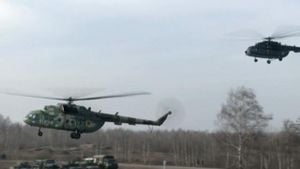Recent concerns over potential sabotage of air cargo operations have intensified, following allegations from Lithuanian authorities. The allegations point to Russian military intelligence orchestrated plots against U.S.-bound cargo aircraft, reflecting increasingly bold tactics amid the conflict with Ukraine.
The sources of this alarming claim trace back to incidents involving incendiary devices discovered at DHL facilities across Europe. Kęstutis Budrys, adviser to Lithuanian President Gitanas Nausėda, has identified Russia’s military espionage agency, the GRU, as behind this troubling plot. Budrys firmly stated, “The Presidency confirms Russian military intelligence is behind the transport of incendiary packages, and we are telling our allies this is not random; it’s part of their military operations.”
Specifically, Budrys noted the recent igniting of one of these incendiary devices at the DHL depot located in Leipzig, Germany, which occurred back in July. Additional similar devices are believed to have caught fire at transport companies near Warsaw, Poland, and near Birmingham, England. Such incidents raise grave concerns about the security of air travel and the risk posed to civilian lives.
This series of events prompted the Lithuanian government to demand serious responses from NATO. Authorities there are currently investigating the origins of these incendiary devices, some of which have been traced back to Lithuania itself, with several arrests having been made already.
An explosive expert familiar with the scenario described these devices as “personal massagers” filled with magnesium-based incendiary materials, stating, “Magnesium fires are exceptionally tough to extinguish without specialized firefighting gear, which is typically absent on commercial aircraft.” This expertise underlines how catastrophic the consequences could be if such devices were successfully smuggled aboard flights.
The urgency escalated when it became known through Western security assessments, as reported by The Wall Street Journal, about two incendiary devices shipped through DHL as part of what’s believed to be Russian attempts at select sabotage aimed at cargo aircraft flying to the U.S. and Canada. Authorities underlined these incidents form part of broader efforts to disrupt NATO-supported operations aiding Ukraine against the Russian invasion.
Despite fears, counter-responses have been observed, with U.S. officials asserting their commitment to address the potential threats to aviation systems. They emphasized collaboration with various industry sectors to fortify protections against any forms of attacks, also referencing their 2025 Homeland Threat Assessment.
Security experts have expressed apprehension around this situation as it could imply there's blatantly provocative behavior from Moscow. Some speculate whether it reflects desperation from the Kremlin as their war efforts continue to be met with stiff resistance from Ukraine.
While this situation bears notable parallels with Russia’s previous tactics, the logic of such acts remains heavily contested. Analysts ponder the reasoning behind endangering civilian air traffic, questioning what strategic gains could possibly arise for Russia from such reckless actions.
Further adding to the complexity, discussions take shape around the interpretation of these events as part of Russia's grander hybrid war strategy aimed at NATO and its allies. The multidimensional nature of warfare today, which merges traditional military actions with cyber and psychological tactics, informs how we understand these threats. The apparent choreography of events raises questions around coordination within Russian military operations beyond Ukraine’s border.
Continuing on the topic, the Ukrainian concrete response has also not been dulled by these developments. The Security Service of Ukraine (SBU) recently caught wind of local plots manifesting within Ukraine’s borders, where they were able to thwart arson attacks allegedly instigated by Russian agents. It raises significant concerns about the domestic climate standing firm against external forces trying to unravel Ukraine amid the continued tumult of on-ground conflict.
The resonance of these threats pushes governments, particularly NATO countries, to view these incidents not as isolated events but as interconnected parts of broader patterns aiming to test the resolve of collective defense pacts and support systems. Carolina Chase, expert on European security dynamics, highlighted how this might be viewed as part of Moscow’s push against NATO, stating, “We need to remain vigilant and proactive about these kinds of activities. They are deliberately engineered to provoke anxiety and remind us of our vulnerabilities.”
But why does the Kremlin engage with tactics which could threaten civil aviation? The motives remain complex and layered. Some speculate it might counterbalance the military deficits experienced on the ground against Ukraine, representing heightened risks taken by Russia which value strategic intimidation over rational engagement. Others argue it reflects the increasing complexity and desperation of the Kremlin’s decision-making after prolonged setbacks.
Current events are characterized by rapid developments and suggest ever-more sophisticated espionage operations might be undertaken as the pressures of the international battlefield evolve. Observers note how strengthening cooperation within NATO members has begun to highlight the importance of mutual defense, as the international community acknowledges dynamics shifting quickly with unexpected urgency. ”We cannot afford complacency,” Chase warned about the collective response.
With these globally reverberant dynamics, it appears we are moving toward the realization of interlinked threats across various dimensions — and the potential for future provocations from state actors appears to loom large. Each incident prompts new evaluations of preparedness, as high-stakes scenarios will likely punctuate international discourse over the coming months. The ramifications of these plots will not only shape immediate military strategies but will also inform the geopolitical landscapes and alliances cultivated through interaction across nations.



